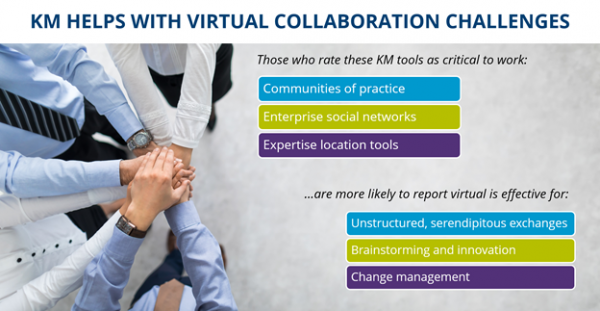
Last year, as the unplanned transition to all-remote work left many organizations flailing, knowledge management rode to the rescue. KM teams helped transition corporate meetings and events online, rolled out new cloud platforms and apps, and taught people how to collaborate when they could no longer just grab a conference room or yell over the cubicle wall. It was a “teachable moment” for digital knowledge exchange, and KM rose to meet that moment.
2021 marks a progression from stopgaps to sustainable strategy. KM teams must capitalize on the workforce’s new-found enthusiasm for digital tools while addressing missteps made in the throes of crisis. Because the reality is, everyone started collaborating virtually a lot more last year—but primarily with people they already knew, and primarily for tasks that are easy to move online. In the next phase, organizations must coax employees beyond this low-hanging fruit to embrace the silo-busting and relationship-building capabilities of true digital knowledge management.
Encourage More Open Knowledge Sharing
2020 was a banner year for virtual collaboration. Erstwhile luddites are now happily Zooming, co-authoring in the cloud, and adding Office Space GIFs to chat threads. But this explosion of activity has been mostly confined inside teams and projects. People are replicating the conversations that used to take place in the office, but not reaching outside their normal circles to crowdsource ideas, build new relationships, and tap into the collective wisdom of the enterprise.
This is abundantly clear in APQC’s Virtual Collaboration: Rules of the Road research. Nearly 3 in 5 survey participants rate project and team-based collaboration sites as highly critical to their work. More than half say these sites have become significantly more critical to getting work done and sourcing needed information since the onset of the pandemic. Chat groups for teams and projects are slightly less ubiquitous, but nearly half report that these groups have become significantly more critical to building and maintaining relationships with coworkers. Employees are also taking more advantage of direct messaging through collaboration platforms.
However, we don’t see the same upswing when it comes to open, boundary-spanning collaboration. Less than a quarter of participants rate communities of practice, enterprise social networks, or expertise location tools as highly critical to their work, and these approaches received only small bumps in the wake of the pandemic. In the transition to virtual work, people simply haven’t turned to core KM tools as much as they might have.
The emphasis on team- and project-based collaboration is not surprising. People’s work lives have been turned upside down, and their most immediate need—and instinct—has been to faithfully replicate what they had lost. And admittedly, daily interaction with close coworkers is essential to keeping the lights on and getting things done.
But when employees collaborate only in pre-established closed groups, they aren’t realizing the full benefits of the tools they’ve embraced. Communities, enterprise social networks, and expertise location tools allow people to connect with likeminded colleagues regardless of team affiliation, surface hidden expertise, and seek out global perspectives. All of this is critical to the kind of innovation and creative problem solving required to respond to breakneck change. If people stay within the walled gardens of department chat, they’re leaving a lot on the table.
The good news is that participating in a virtual community or enterprise social network uses many of the same skills that employees have honed in team-based sites. And with the mechanics of participation less of a hurdle for users, KM can focus on the incentives and cultural queues that position open channels as safe and rewarding places to engage. These aren’t easy challenges to overcome, but we have a golden opportunity to capitalize on digital trends and take open knowledge sharing to the next level.
Fill Gaps in What the Digital Workplace Can Do
Another problem KM must help solve in 2021 is the struggle to shift certain work online. Virtual is highly effective for teamwork, status updates, and co-creating deliverables. But as you progress to more strategic and complex activities, effectiveness starts to drop off. Virtual is particularly problematic for innovation, problem solving, and informal “water cooler” conversations. In fact, the difficulties of moving these activities online are survey respondents’ top two challenges with virtual work.
Ironically, the solution to this second challenge echoes the first. KM tools that enable dynamic interactions with expansive, diverse networks make it easier to innovate and solve problems when working virtually. Because people can slip in and out of conversations based on time and inclination, open threads are ideal for water-cooler style conversations. Participants can bounce ideas off one another, ask for help with tough problems, or validate decisions without worrying that they’re “bothering” a particular colleague with a direct request. Coworkers with a free moment will speak up, building off one another’s contributions and creating a digital record that others can learn from.
Data analysis bears out KM’s ability to fill gaps that other forms of virtual collaboration leave behind. Respondents who report that virtual is effective for more challenging work—including brainstorming and innovation, change management, and serendipitous exchanges—are significantly more likely to say that communities, enterprise social networks, and expertise location tools are critical to their work. Comparatively few people have embraced KM as a solution to remote collaboration, but those who have are reaping the rewards.
The Time Is Now
Employees are still adjusting to the digital workplace, and their new habits have not yet ossified into inflexible routines. At the same time, many are coming to terms with virtual working as a longer-term trend, rather than a flash-in-the-pan response to a short-term disaster. Even as life (hopefully) inches closer to the pre-pandemic status quo, the toothpaste is not going back in the tube. Some organizations are going all-virtual, and many more are gravitating toward more remote jobs, hybrid schedules, and virtual meetings in place of expensive travel.
Even people raring to get back to the office will spend more time collaborating online—and they will be looking for ways to optimize that experience. If KM can present itself as a solution to the challenges of the digital workplace, it has a chance to supercharge adoption and embed digital knowledge exchange into the fabric of the organization. In this way, KM can make 2021 its year.
